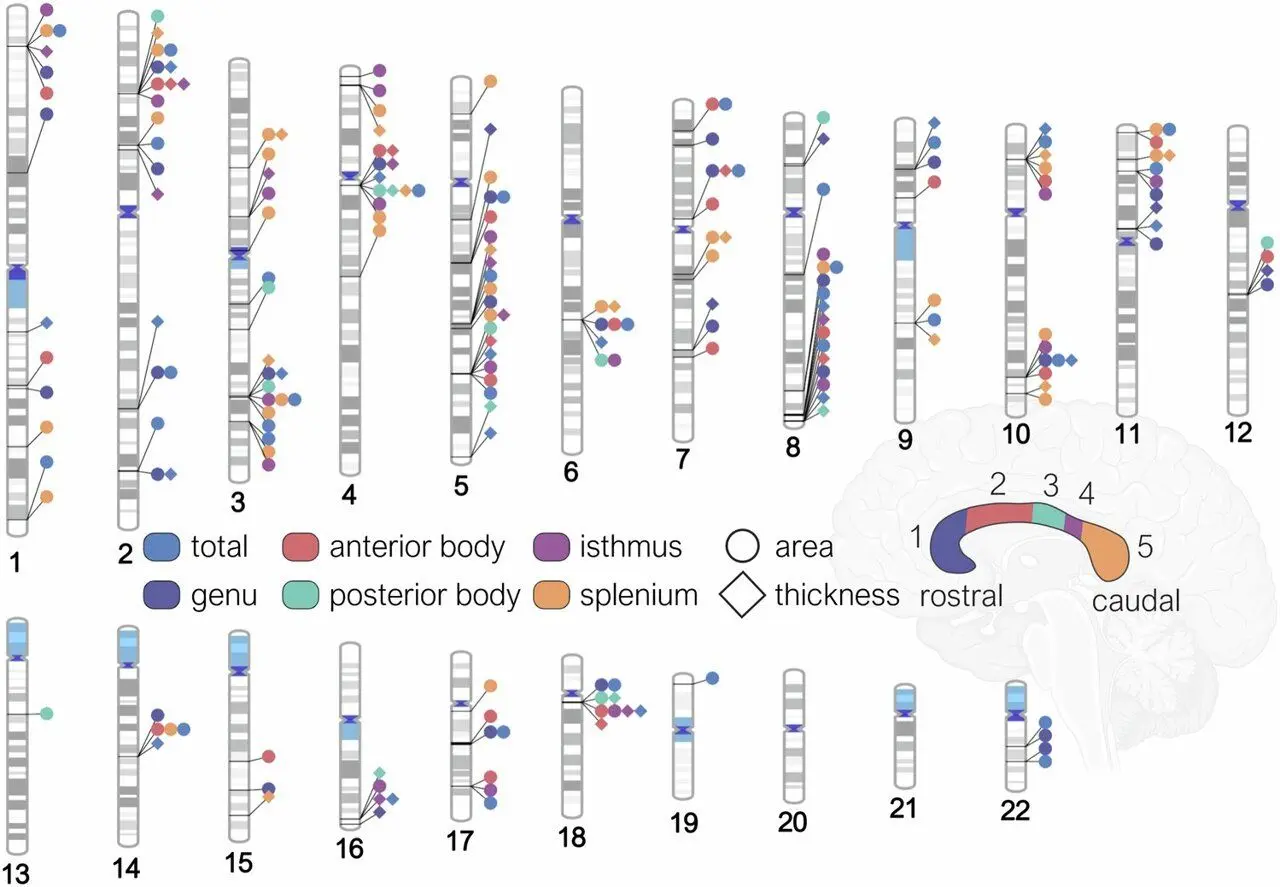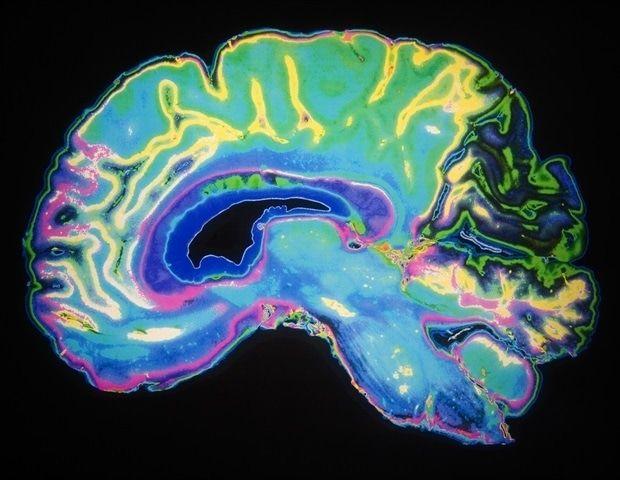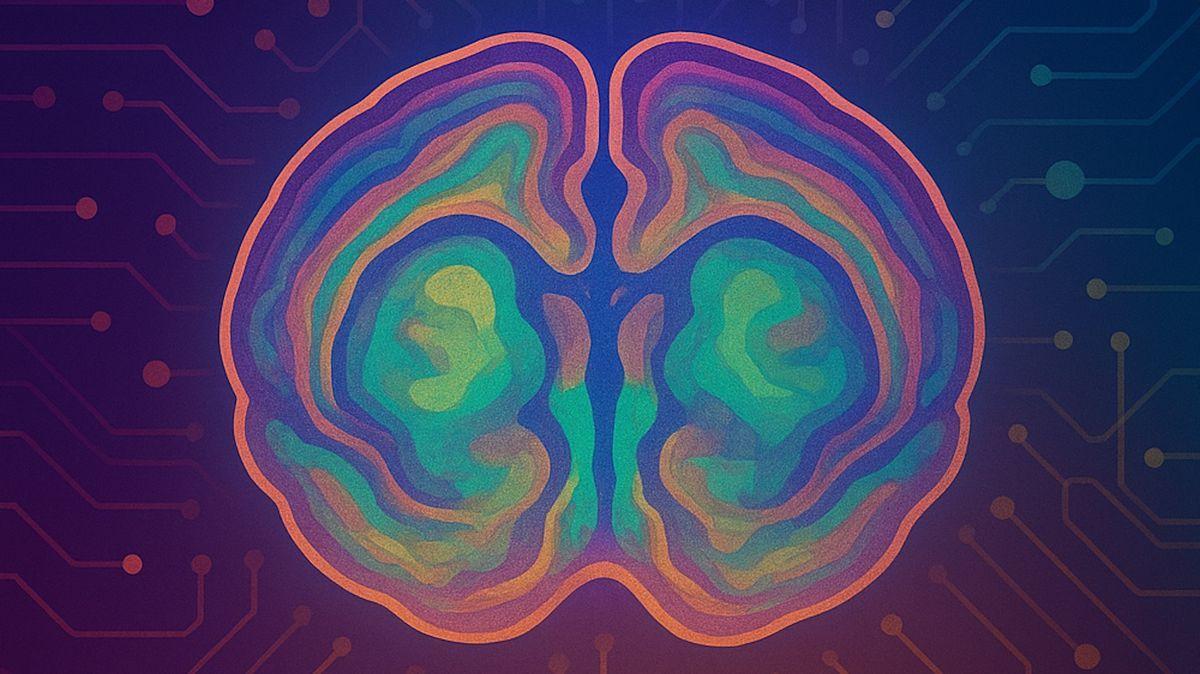AI Tool Maps Genetic Blueprint of Brain's Communication Bridge, Unlocking Mental Health Insights
2 Sources
2 Sources
[1]
AI Maps the Brain's Hidden Bridge, Revealing Genetic Links to Mental Health - Neuroscience News
Summary: For the first time, scientists have mapped the genetic architecture of the brain's communication bridge -- the corpus callosum -- using AI and MRI data from over 50,000 people. The study uncovered dozens of genes that shape this vital structure's size and thickness, many active during prenatal development when the brain's wiring is established. Differences in these genes may explain why changes in the corpus callosum are associated with mental and neurological disorders. The team's open-source AI tool now enables global researchers to analyze brain structure faster and with unprecedented precision. For the first time, a research team led by the Mark and Mary Stevens Neuroimaging and Informatics Institute (Stevens INI) at the Keck School of Medicine of USC has mapped the genetic architecture of a crucial part of the human brain known as the corpus callosum -- the thick band of nerve fibers that connects the brain's left and right hemispheres. The findings open new pathways for discoveries about mental illness, neurological disorders and other diseases related to defects in this part of the brain. The corpus callosum is critical for nearly everything the brain does, from coordinating the movement of our limbs in sync to integrating sights and sounds, to higher-order thinking and decision-making. Abnormalities in its shape and size have long been linked to disorders such as ADHD, bipolar disorder, and Parkinson's disease. Until now, the genetic underpinnings of this vital structure remained largely unknown. In the new study, published in Nature Communications, the team analyzed brain scans and genetic data from over 50,000 people, ranging from childhood to late adulthood, with the help of a new tool the team created that leverages artificial intelligence. "We developed an AI tool that finds the corpus callosum in different types of brain MRI scans and automatically takes its measurements," said Shruti P. Gadewar, co-first author of the study and research specialist at the Stevens INI. Using this tool, the researchers identified dozens of genetic regions that influence the size and thickness of the corpus callosum and its subregions. "These findings provide a genetic blueprint for one of the brain's most essential communication pathways," said Ravi R. Bhatt, PhD, co-first author of the study and a post-doctoral scholar at the Stevens INI's Imaging Genetics Center. "By uncovering how specific genes shape the corpus callosum and its subregions, we can start to understand why differences in this structure are linked to various mental health and neurological conditions at a molecular level." The study revealed that different sets of genes govern the area versus the thickness of the corpus callosum -- two features that change across the lifespan and play distinct roles in brain function. Several of the implicated genes are active during prenatal brain development, particularly in processes like cell growth, programmed cell death, and the wiring of nerve fibers across hemispheres. "This work demonstrates the power of using AI and large-scale databases to uncover the genetic factors driving brain development," said Neda Jahanshad, PhD, associate professor of neurology and senior author. "By linking genetics to brain structure, we gain critical insight into the biological pathways that may underlie psychiatric and neurological diseases." Notably, the study found genetic overlap between the corpus callosum and the cerebral cortex -- the outer layer of the brain responsible for memory, attention, and language -- as well as with conditions such as ADHD and bipolar disorder. "These connections underscore that the same genetic factors shaping the brain's communication bridge may also contribute to vulnerabilities for certain disorders," Jahanshad added. Arthur W. Toga, PhD, director of the Stevens INI, emphasized the broader implications of this research. "This study is a landmark in understanding how our brains are built. It not only sheds light on normal brain development but also helps us identify new avenues for diagnosing and potentially treating disorders that affect millions worldwide." The researchers have made their new AI-based tool publicly available to accelerate future discoveries. The software, developed at the Stevens INI, uses advanced machine learning to identify and measure the corpus callosum from MRI scans automatically. This approach allows scientists to analyze brain structure at an unprecedented scale and level of precision, reducing years of manual work to just hours. The Stevens INI has become a global leader in applying artificial intelligence to neuroscience, developing tools that are freely shared with the research community. By combining massive datasets with cutting-edge computational methods, the institute is transforming how scientists study brain health and disease. "Artificial intelligence is revolutionizing brain research, and Stevens INI is at the forefront of that revolution," said Toga. "By pioneering AI tools and making them widely available, we're empowering scientists around the world to unlock new discoveries about the brain far faster than ever before." About the study In addition to Bhatt, Gadewar and Jahanshad, the study's other authors include Ankush Shetty, Iyad Ba Gari, Elizabeth Haddad,Shayan Javid, Abhinaav Ramesh, Elnaz Nourollahimoghadam, Alyssa H. Zhu, Christiaan de Leeuw,Paul M. Thompson,and Sarah E. Medland. Funding: This work was supported by the National Institutes of Health (Grant Nos. R01 MH134004 and R01 AG059874 [NJ], National Science Foundation Graduate Research Fellowship Program (Grant No. 2020290241 [RRB], R01 MH126213, R01NS105746, the Adolescent Brain Cognitive Development (ABCD) Study (https://abcdstudy.org), and UK Biobank (Resource Application No. 11559). SEM was supported by NHMRC grants APP1172917 and APP1158127. Research reported in this publication was supported by the Office of the Director, National Institutes of Health under Award Number S10OD032285. The Genetic Architecture of the Human Corpus Callosum and its Subregions The corpus callosum (CC) is the largest set of white matter fibers connecting the two hemispheres of the brain. In humans, it is essential for coordinating sensorimotor responses and performing associative or executive functions. Identifying which genetic variants underpin CC morphometry can provide molecular insights into the CC's role in mediating cognitive processes. We developed and used an artificial intelligence based tool to extract the midsagittal CC's total and regional area and thickness in two large public datasets. We performed a genome-wide association study (GWAS) meta-analysis of European participants (combined N = 46,685) with generalization to the non-European participants (combined N = 7040). Post-GWAS analyses implicated prenatal intracellular organization and cell growth patterns, and high heritability in regions of open chromatin. Results suggest programmed cell death mediated by the immune system drives the thinning of the posterior body and isthmus. Genetic overlap, and causal genetic liability, between the CC, cerebral cortex features, and neuropsychiatric disorders such as attention-deficit/hyperactivity, bipolar disorders, and Parkinson's disease were identified.
[2]
AI tool uncovers genetic blueprint of the brain's largest communication bridge
For the first time, a research team led by the Mark and Mary Stevens Neuroimaging and Informatics Institute (Stevens INI) at the Keck School of Medicine of USC has mapped the genetic architecture of a crucial part of the human brain known as the corpus callosum -- the thick band of nerve fibers that connects the brain's left and right hemispheres. The findings open new pathways for discoveries about mental illness, neurological disorders and other diseases related to defects in this part of the brain. The corpus callosum is critical for nearly everything the brain does, from coordinating the movement of our limbs in sync to integrating sights and sounds, to higher-order thinking and decision-making. Abnormalities in its shape and size have long been linked to disorders such as ADHD, bipolar disorder, and Parkinson's disease. Until now, the genetic underpinnings of this vital structure had remained largely unknown. In the new study, published in Nature Communications, the team analyzed brain scans and genetic data from over 50,000 people, ranging from childhood to late adulthood, with the help of a new tool the team created that leverages artificial intelligence. "We developed an AI tool that finds the corpus callosum in different types of brain MRI scans and automatically takes its measurements," said Shruti P. Gadewar, co-first author of the study and research specialist at the Stevens INI. Using this tool, the researchers identified dozens of genetic regions that influence the size and thickness of the corpus callosum and its subregions. "These findings provide a genetic blueprint for one of the brain's most essential communication pathways," said Ravi R. Bhatt, Ph.D., co-first author of the study and a postdoctoral scholar at the Stevens INI's Imaging Genetics Center. "By uncovering how specific genes shape the corpus callosum and its subregions, we can start to understand why differences in this structure are linked to various mental health and neurological conditions at a molecular level." The study revealed that different sets of genes govern the area versus the thickness of the corpus callosum -- two features that change across the lifespan and play distinct roles in brain function. Several of the implicated genes are active during prenatal brain development, particularly in processes like cell growth, programmed cell death, and the wiring of nerve fibers across hemispheres. "This work demonstrates the power of using AI and large-scale databases to uncover the genetic factors driving brain development," said Neda Jahanshad, Ph.D., associate professor of neurology and senior author. "By linking genetics to brain structure, we gain critical insight into the biological pathways that may underlie psychiatric and neurological diseases." Notably, the study found genetic overlap between the corpus callosum and the cerebral cortex -- the outer layer of the brain responsible for memory, attention, and language -- as well as with conditions such as ADHD and bipolar disorder. "These connections underscore that the same genetic factors shaping the brain's communication bridge may also contribute to vulnerabilities for certain disorders," Jahanshad added. Arthur W. Toga, Ph.D., director of the Stevens INI, emphasized the broader implications of this research, stating, "This study is a landmark in understanding how our brains are built. It not only sheds light on normal brain development but also helps us identify new avenues for diagnosing and potentially treating disorders that affect millions worldwide." The researchers have made their new AI-based tool publicly available to accelerate future discoveries. The software, developed at the Stevens INI, uses advanced machine learning to identify and measure the corpus callosum from MRI scans automatically. This approach allows scientists to analyze brain structure at an unprecedented scale and level of precision, reducing years of manual work to just hours. The Stevens INI has become a global leader in applying artificial intelligence to neuroscience, developing tools that are freely shared with the research community. By combining massive datasets with cutting-edge computational methods, the institute is transforming how scientists study brain health and disease. "Artificial intelligence is revolutionizing brain research, and Stevens INI is at the forefront of that revolution," said Toga. "By pioneering AI tools and making them widely available, we're empowering scientists around the world to unlock new discoveries about the brain far faster than ever before."
Share
Share
Copy Link
Researchers at USC have used AI to map the genetic architecture of the corpus callosum for the first time, analyzing data from over 50,000 people. The breakthrough identifies dozens of genes that shape this crucial brain structure and reveals genetic links to mental health disorders like ADHD and bipolar disorder.
Groundbreaking AI Research Maps Brain's Communication Highway
Scientists at the Mark and Mary Stevens Neuroimaging and Informatics Institute (Stevens INI) at USC's Keck School of Medicine have achieved a historic milestone in neuroscience by creating the first comprehensive genetic map of the corpus callosum, the brain's largest communication bridge connecting its left and right hemispheres
1
. This breakthrough research, published in Nature Communications, analyzed brain scans and genetic data from over 50,000 individuals spanning from childhood to late adulthood2
.The corpus callosum serves as a critical neural highway, facilitating nearly every brain function from coordinating synchronized limb movements to integrating sensory information and enabling complex cognitive processes like decision-making
1
. Abnormalities in this structure's shape and size have long been associated with various neurological and psychiatric conditions, including ADHD, bipolar disorder, and Parkinson's disease, yet its genetic foundations remained largely mysterious until now2
.Revolutionary AI Tool Transforms Brain Analysis
The research team developed an innovative artificial intelligence tool that automatically identifies and measures the corpus callosum across different types of brain MRI scans. "We developed an AI tool that finds the corpus callosum in different types of brain MRI scans and automatically takes its measurements," explained Shruti P. Gadewar, co-first author and research specialist at Stevens INI
1
.This technological advancement represents a paradigm shift in neuroscience research methodology, reducing what previously required years of manual analysis to just hours of automated processing
2
. The tool's precision and scalability enable researchers worldwide to analyze brain structures at unprecedented levels of detail and scope.Genetic Blueprint Reveals Developmental Insights
Using their AI system, researchers identified dozens of genetic regions that influence both the size and thickness of the corpus callosum and its various subregions. The study revealed a fascinating complexity: different gene sets govern the structure's area versus its thickness, two distinct features that change throughout human development and serve unique functional roles
1
.
Source: Medical Xpress
Particularly significant was the discovery that many implicated genes are highly active during prenatal brain development, specifically during critical processes such as cell growth, programmed cell death, and the formation of nerve fiber connections between brain hemispheres
2
. "These findings provide a genetic blueprint for one of the brain's most essential communication pathways," noted co-first author Dr. Ravi R. Bhatt, a postdoctoral scholar at Stevens INI's Imaging Genetics Center1
.Related Stories
Mental Health Connections Unveiled
The research uncovered compelling genetic overlaps between the corpus callosum and the cerebral cortex, the brain's outer layer responsible for memory, attention, and language processing
2
. More importantly, the study identified genetic connections with psychiatric conditions including ADHD and bipolar disorder, providing molecular-level insights into why structural differences in this brain region correlate with various mental health conditions."These connections underscore that the same genetic factors shaping the brain's communication bridge may also contribute to vulnerabilities for certain disorders," emphasized Dr. Neda Jahanshad, associate professor of neurology and senior author of the study
1
. This discovery opens new avenues for understanding the biological pathways underlying psychiatric and neurological diseases.Global Impact and Future Implications
The researchers have made their AI-based tool publicly available, democratizing access to advanced brain analysis capabilities for the global scientific community
2
. Dr. Arthur W. Toga, director of Stevens INI, highlighted the broader significance: "This study is a landmark in understanding how our brains are built. It not only sheds light on normal brain development but also helps us identify new avenues for diagnosing and potentially treating disorders that affect millions worldwide"1
.The Stevens INI has established itself as a global leader in applying artificial intelligence to neuroscience, consistently developing tools that are freely shared with researchers worldwide. By combining massive datasets with cutting-edge computational methods, the institute is fundamentally transforming approaches to studying brain health and disease
2
.References
Summarized by
Navi
[1]
Related Stories
AI Algorithm Uncovers Complex DNA Variants Linked to Psychiatric Disorders
22 Oct 2024•Science and Research

AI Breakthrough Accelerates Discovery of Genes Linked to Neurodevelopmental Disorders
27 Feb 2025•Science and Research

AI-Powered NextBrain Atlas Creates Most Detailed 3D Map of Human Brain for Medical Imaging
05 Nov 2025•Science and Research

Recent Highlights
1
Google launches Gemini 3 Flash as default AI model, delivering speed with Pro-grade reasoning
Technology

2
OpenAI launches GPT Image 1.5 as AI image generator war with Google intensifies
Technology

3
OpenAI launches ChatGPT app store, opening doors for third-party developers to build AI-powered apps
Technology





